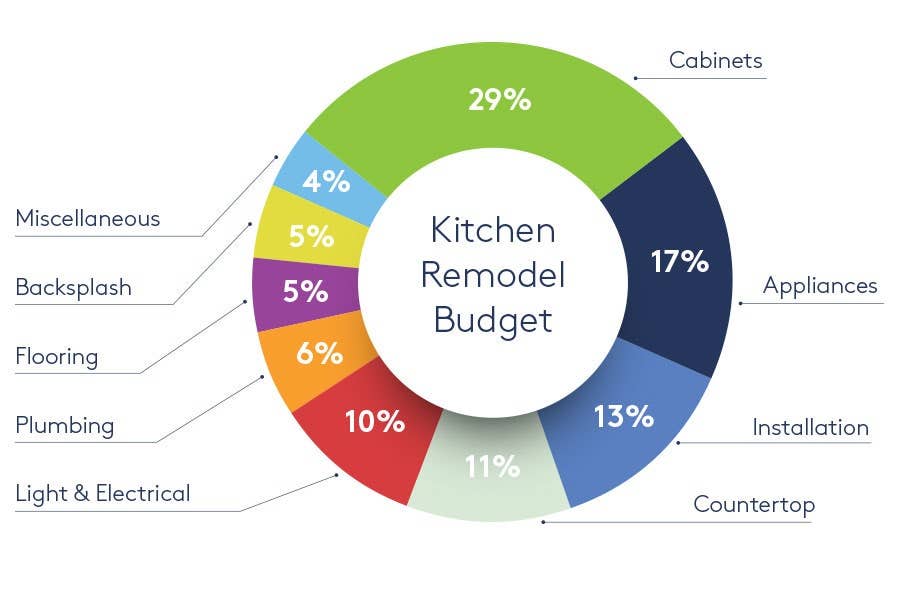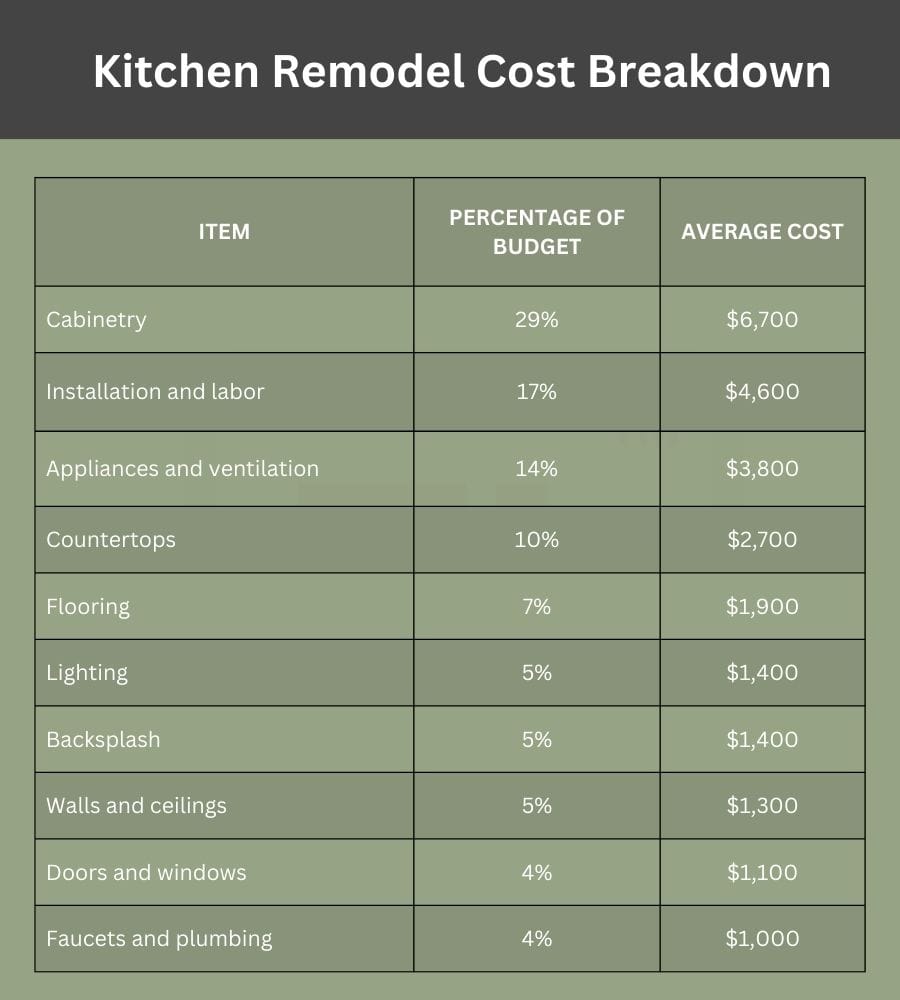What is the Cost to Renovate a Kitchen? The cost to renovate a kitchen is the total financial investment required to update, redesign, or completely overhaul your kitchen space. This cost is highly variable, influenced by the scope of work, material choices, labor rates, and unexpected issues. Understanding these factors is crucial for effective budgeting and achieving your dream kitchen without financial surprises.
Understanding Kitchen Renovation Costs: A Detailed Breakdown
Renovating a kitchen is a significant investment, and its cost is a mosaic of many individual components. By dissecting these elements, you can gain a clearer picture of where your money will go and how to optimize your budget.
What is it? Defining Your Kitchen Renovation
Before diving into numbers, it’s essential to define the type and extent of your kitchen renovation. This initial clarity will be the most significant determinant of your overall budget.
•Minor Cosmetic Update: This typically involves refreshing the existing space without changing the layout. Think new paint, cabinet refacing, updated hardware, a new backsplash, and perhaps new light fixtures. This is the most budget-friendly option.
•Mid-Range Renovation: This often includes replacing cabinets, countertops, and appliances, and potentially making minor layout adjustments. It aims for a significant aesthetic and functional upgrade without major structural changes.
•Major Renovation/Expansion: This involves a complete overhaul, often including changing the kitchen layout, moving plumbing or electrical lines, removing or adding walls, and installing high-end materials and appliances. This is the most expensive category, sometimes involving structural engineering.
How it Affects Cost: The more extensive and luxurious your renovation, the higher the cost. A minor update might range from 10,000 to 10,000 to 10,000 to 25,000, a mid-range from 25,000 to 25,000 to 25,000 to 75,000, and a major renovation can easily exceed $75,000, reaching well into six figures depending on size and finishes.

A pie chart illustrating the typical breakdown of a kitchen remodel budget, highlighting major categories like cabinets, appliances, and installation.
Steps: The Renovation Process and Associated Costs
Each phase of a kitchen renovation project incurs specific costs. Understanding these steps helps in anticipating expenses and managing the project flow.
1.Planning and Design (5-10% of Budget):
•What is it? This initial phase involves conceptualizing your new kitchen, creating layouts, selecting materials, and often hiring a kitchen designer or architect. It’s where your vision takes shape.
•Costs Involved: Fees for designers, architects, and potentially structural engineers. Costs for preliminary site visits, detailed drawings, and material selection consultations.
•Features: Detailed floor plans, 3D renderings, material specifications, and project timelines. This step ensures all elements are cohesive and functional before physical work begins.
2.Demolition (2-5% of Budget):
•What is it? The removal of old cabinets, countertops, flooring, and potentially walls to prepare the space for the new installation.
•Costs Involved: Labor for demolition, debris removal, and disposal fees. Costs can increase if hazardous materials (e.g., asbestos, lead paint) are discovered.
•Features: Cleared space, ready for new construction. This step often reveals hidden issues that might impact subsequent costs.
3.Structural Changes (Variable, can be significant):
•What is it? Alterations to the kitchen’s structure, such as removing load-bearing walls, adding new windows or doors, or expanding the kitchen footprint.
•Costs Involved: High labor costs for specialized contractors (e.g., structural engineers, carpenters), materials for new framing, and increased permit fees.
•Features: A completely reconfigured space, potentially with an open-concept design or increased square footage.
4.Rough-Ins (Plumbing, Electrical, HVAC) (10-15% of Budget):
•What is it? Installation or relocation of plumbing lines, electrical wiring, and HVAC ducts according to the new kitchen design. This happens behind the walls.
•Costs Involved: Licensed plumbers, electricians, and HVAC technicians. Costs for new pipes, wires, outlets, and ductwork. Inspections are required at this stage.
•Features: Functional and safe infrastructure for all kitchen appliances and fixtures, meeting current building codes.
5.Flooring (5-10% of Budget):
•What is it? Installation of new kitchen flooring, ranging from laminate and vinyl to hardwood, tile, or natural stone.
•Costs Involved: Material cost per square foot, labor for installation, and subfloor preparation if needed. Higher-end materials and complex patterns increase costs.
•Features: A durable, aesthetically pleasing, and easy-to-clean surface that complements the kitchen’s overall design.
6.Cabinetry (25-40% of Budget):
•What is it? The largest single expense in most kitchen renovations, involving the selection, purchase, and installation of new cabinets.
•Costs Involved: Varies significantly by type (stock, semi-custom, custom), material (MDF, plywood, solid wood), finish, and hardware. Installation labor is also a major factor.
•Features: Storage solutions, aesthetic appeal, and the functional backbone of your kitchen. Custom cabinets offer tailored solutions and unique designs.
7.Countertops (10-15% of Budget):
•What is it? The work surfaces in your kitchen, available in a vast array of materials like laminate, solid surface, quartz, granite, marble, and butcher block.
•Costs Involved: Material cost per square foot, fabrication, and installation. Natural stones and engineered quartz are typically more expensive.
•Features: Durable and attractive work surfaces that withstand daily use and enhance the kitchen’s design.
8.Appliances (10-20% of Budget):
•What is it? Purchase and installation of new kitchen appliances, including refrigerator, range, dishwasher, microwave, and potentially specialty items like wine coolers or built-in coffee makers.
•Costs Involved: Varies widely based on brand, features, energy efficiency, and finish. Installation costs for integrated or gas appliances.
•Features: Modern functionality, energy efficiency, and a sleek look that integrates with the kitchen’s design.
9.Backsplash (1-3% of Budget):
•What is it? The protective and decorative surface installed on the wall between the countertops and upper cabinets.
•Costs Involved: Material cost (tile, stone, glass, metal) and labor for installation. Complex patterns or expensive materials increase costs.
•Features: Adds a finishing touch, protects walls from splashes, and contributes significantly to the kitchen’s aesthetic.
10.Lighting (5-10% of Budget):
•What is it? Installation of various lighting types, including ambient (general), task (under-cabinet, pendant), and accent lighting.
•Costs Involved: Fixture costs, electrical work for new wiring or relocation, and installation labor.
•Features: Enhances functionality, creates ambiance, and highlights design elements.
11.Painting and Finishing Touches (1-3% of Budget):
•What is it? Final painting, trim work, and installation of hardware, window treatments, and decorative elements.
•Costs Involved: Paint, brushes, and labor for painting. Costs for decorative items and final styling.
•Features: Completes the kitchen’s look, adding personality and polish.

A detailed infographic breaking down the typical costs associated with a kitchen remodel, showing percentages for each category.
Teams: Who You’ll Hire for Your Kitchen Renovation
Successfully renovating a kitchen often requires a team of skilled professionals. Understanding their roles and when to engage them is key to a smooth project.
•General Contractor (GC):
•What is it? The primary point of contact and overall project manager. The GC oversees all aspects of the renovation, coordinates subcontractors, manages the schedule, and ensures the project stays on track and within budget.
•Features: Single point of accountability, streamlined communication, and expertise in managing complex construction projects. They handle permits, inspections, and quality control.
•Kitchen Designer:
•What is it? A specialist who helps you plan the layout, select materials, and optimize the functionality and aesthetics of your kitchen. They translate your vision into practical designs.
•Features: Expertise in kitchen ergonomics, material trends, and space planning. They can provide detailed drawings, material specifications, and often have access to trade discounts.
•Architect/Structural Engineer (for major renovations):
•What is it? An architect designs the overall space, especially if walls are being moved or the footprint is changing. A structural engineer assesses and designs solutions for load-bearing elements.
•Features: Ensures structural integrity and compliance with building codes for significant layout changes. Provides stamped drawings for permits.
•Plumber:
•What is it? A licensed professional responsible for installing, relocating, or repairing water supply lines, drains, and gas lines for sinks, dishwashers, refrigerators, and gas ranges.
•Features: Ensures proper water pressure, drainage, and gas safety. Essential for any changes involving water or gas lines.
•Electrician:
•What is it? A licensed professional who handles all electrical work, including installing new outlets, wiring for appliances, lighting, and ensuring the electrical system can handle the new load.
•Features: Ensures electrical safety, proper circuiting, and compliance with electrical codes. Crucial for new appliance installations and lighting schemes.
•Cabinet Installer:
•What is it? Specialists in the precise installation of kitchen cabinets, ensuring they are level, plumb, and securely mounted.
•Features: Professional installation that guarantees the longevity and functionality of your cabinetry, often a critical step for the overall kitchen aesthetic.
•Countertop Fabricator/Installer:
•What is it? Professionals who measure, cut, and install your chosen countertop material, ensuring a perfect fit and finish.
•Features: Precision cutting and seamless installation of delicate and heavy materials like stone or quartz.
•Flooring Installer:
•What is it? Experts in preparing the subfloor and installing your chosen flooring material, whether it’s tile, hardwood, laminate, or vinyl.
•Features: Ensures a level, durable, and aesthetically pleasing floor that can withstand kitchen traffic.
Features: What Drives Up the Cost?
The features you choose for your kitchen can dramatically impact the final cost. Opting for premium or custom features will elevate your budget.
•Custom Cabinetry vs. Stock: Custom cabinets are built to your exact specifications, offering unique sizes, finishes, and storage solutions. Stock cabinets are pre-manufactured in standard sizes. Custom options are significantly more expensive but offer unparalleled personalization and fit.
•High-End Appliances: Professional-grade ranges, built-in refrigerators, smart appliances, and specialty items like wine fridges or espresso makers come with a hefty price tag. Their installation can also be more complex and costly.
•Premium Countertop Materials: Natural stone (marble, granite) and high-end engineered quartz are more expensive than laminate or solid surface options. Their fabrication and installation also require specialized skills.
•Complex Layout Changes: Moving plumbing lines, gas lines, or electrical outlets is more expensive than keeping them in their original locations. Any structural changes, like removing load-bearing walls, add significant costs due to engineering and additional labor.
•Smart Home Integration: Incorporating smart lighting, smart appliances, or integrated sound systems adds to the electrical and technology costs.
•Custom Lighting Design: Layered lighting, including recessed lights, pendant lights, under-cabinet lighting, and accent lighting, requires more fixtures and complex electrical work than basic overhead lighting.
•Specialty Features: Items like pot fillers, built-in pantries, custom range hoods, wine refrigerators, or integrated coffee makers add both material and installation costs.
•High-End Fixtures: Designer faucets, sinks (e.g., farmhouse sinks, prep sinks), and unique hardware can significantly increase the overall cost.
XLISE Integration: Your Partner in Kitchen Renovation
Navigating the complexities and costs of a kitchen renovation can be overwhelming, but XLISE is here to simplify the process. Our platform offers a wealth of resources designed to empower you at every stage of your project:
•Detailed Cost Breakdowns: Explore our in-depth articles that provide realistic cost estimates for various kitchen renovation scenarios, helping you set a practical budget.
•Material Selection Guides: Discover comprehensive guides on choosing the right materials for your kitchen, balancing aesthetics, durability, and cost-effectiveness.
•Contractor Vetting Resources: Learn how to find and vet reliable contractors, ensuring you work with qualified professionals who deliver quality results within your budget.
•Budgeting Tools and Tips: Access practical tools and expert tips for managing your renovation finances, identifying potential savings, and avoiding common pitfalls.
•Design Inspiration: Browse our extensive collection of kitchen design ideas, trends, and real-life renovation stories to inspire your project and refine your vision.
At XLISE., we believe that a successful kitchen renovation starts with informed decisions. Let us be your trusted guide, providing the knowledge and support you need to transform your kitchen into the heart of your home, beautifully and affordably.
Frequently Asked Questions (FAQ) about Kitchen Renovation Costs
What is the average cost of a kitchen renovation?
The average cost of a kitchen renovation varies widely based on scope and location. A minor cosmetic update might range from 10,000−10,000-10,000−25,000, a mid-range remodel from 25,000−25,000-25,000−75,000, and a major renovation can exceed $75,000. For more detailed breakdowns, visit kitchen renovation costs.
How much should I set aside for unexpected kitchen renovation costs?
It’s highly recommended to allocate a contingency fund of 10-20% of your total kitchen renovation budget for unforeseen issues. For older homes or extensive remodels, consider 20-25%. Learn more about managing unexpected costs at unexpected renovation costs.
What are the biggest cost drivers in a kitchen renovation?
Cabinets typically account for 25-40% of the budget, followed by appliances (10-20%), and countertops (10-15%). Labor costs for installation and specialized trades also form a significant portion. Explore detailed cost breakdowns at kitchen cost drivers.
Can I save money by doing some of the kitchen renovation myself?
Yes, DIY can save money on labor costs for tasks like demolition, painting, or simple installations. However, complex tasks like plumbing, electrical, or structural work should always be left to licensed professionals for safety and compliance. Find DIY tips at diy renovation savings.
How does kitchen size affect renovation cost?
Larger kitchens generally cost more to renovate due to increased material requirements (more cabinets, countertops, flooring) and potentially more complex layouts that require additional labor. Read more about space planning at kitchen size impact.
Is it cheaper to reface cabinets or replace them entirely?
Refacing cabinets (keeping existing boxes and replacing doors/drawer fronts) is generally 30-50% cheaper than replacing them entirely. It’s a good option if your existing cabinet boxes are in good condition. Compare options at cabinet refacing vs replacement.
What is the typical timeline for a kitchen renovation?
A minor kitchen renovation might take 2-4 weeks. A mid-range remodel typically takes 6-10 weeks. A major renovation or expansion can take 10-16 weeks or even longer, depending on complexity and material lead times. Get project timeline estimates at renovation timelines.
Do I need a kitchen designer for my renovation?
For minor updates, a designer might not be necessary. However, for mid-range to major renovations, a kitchen designer can be invaluable. They help optimize layout, select materials, and ensure a cohesive design, potentially saving you money and headaches in the long run. Find tips on hiring professionals at hiring kitchen designer.
How do I choose the right materials for my kitchen renovation?
Consider your budget, desired aesthetic, durability needs, and maintenance preferences. Research different options for countertops, flooring, and backsplashes. XLISE.com offers detailed guides on material selection to help you make informed choices at kitchen material selection.
What permits are typically required for a kitchen renovation?
Permits are usually required for changes to plumbing, electrical, or gas lines, structural modifications (like removing walls), and sometimes for significant layout changes. Always check with your local building department before starting work. Learn more about permits at renovation permits.
How can I ensure my kitchen renovation stays on budget?
Start with a detailed budget, get multiple quotes, avoid making changes once construction begins, and have a contingency fund. Regular communication with your contractor and tracking expenses are also crucial. Access budgeting tools at budgeting tips.
Where can I find more resources for planning my kitchen renovation?
XLISE.com is an excellent resource! We offer comprehensive articles, budgeting tools, design inspiration, and guides on every aspect of kitchen renovation, from initial planning to final touches. Visit XLISE.com for expert advice and practical tips to make your kitchen renovation a success.





